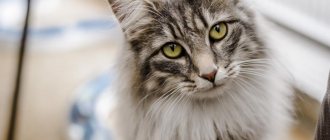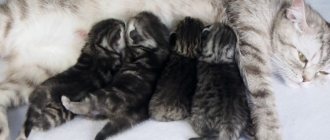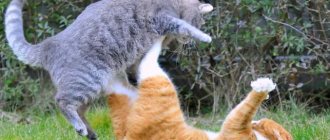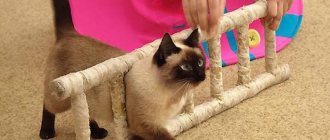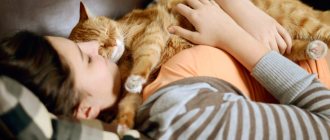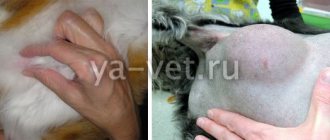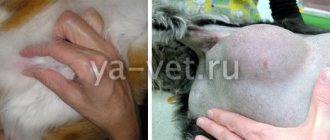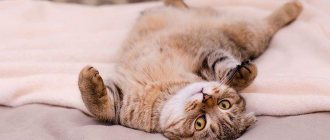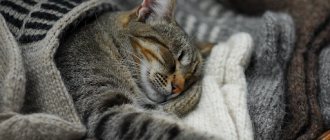Many owners notice a fat tail on a cat - a drooping part of the back of the abdomen. Skin-fat formation is usually a normal phenomenon, indicating age-related and physiological changes, and less often signals a disease. Many pathologies accompanied by the appearance of an abdominal pouch are dangerous and, in advanced cases, lead to the death of the cat. Therefore, the owner must show the pet to a veterinarian.
What is a cat's fat tail?
A cat's fat tail is scientifically called a “primordial pouch,” which means a genetic tendency in some cat breeds to form a fold of skin on the abdomen, between the hind legs.
A small hanging tail is considered normal for cats if it is elastic, soft to the touch, does not cause pain and its size does not exceed 5 cm.
In felinology, there are several theories that explain this anatomical feature in cats:
- The inguinal skin fold is a “depot” for fat deposits, which are consumed during prolonged fasting of a cat, which allows animals to survive in the most difficult circumstances. Fat deposits in cats are especially noticeable during the winter cold.
- The fat tail acts as a repository of excess elastic skin, which is actively used when jumping high, long, while climbing trees or when entering narrow crevices, when the cat needs to stretch out “in line” to get to the desired place.
- A hanging belly in cats is an additional means of protecting internal organs during fights and fights with relatives. Cats tend to deliver powerful blows to the enemy with their hind legs, and an additional layer of skin will protect the vulnerable belly from damage to internal organs.
All domestic and wild cats have a fat tail, but in some it is more pronounced due to breed or physiological characteristics, in others it is less pronounced.
In spring and summer, the size of the saggy tummy in cats is significantly reduced, and in late autumn and winter the fat tail grows again.
Physiological reasons for the appearance of folds
A skin fold in the groin area usually appears in adult cats that lead a very active lifestyle, as well as after giving birth, while feeding kittens, or during weight loss.
Kittens of hybrid breeds (who have wild and native cats in their family) have a fat tail from a young age and this is considered the norm.
To the touch, the fat tail of a healthy cat or kitten looks like an oblong soft fold of skin in the groin area, inside of which there is a small deposit of homogeneous fatty tissue (without compactions or nodules).
The skin in this area should be thin, mobile, warm, and not cause discomfort to the pet during palpation and stroking.
Breed characteristics
Some cat breeds are characterized by the obligatory presence of a fat tail (a genetically determined trait), these include:
| Cat breed | Phenotype feature |
| Hairless cats | No fur |
| Sphinx (Canadian, Egyptian) | Straight ears |
| Bambino | Shortened paws |
| Elf | Ears turned back |
| Ukrainian Levkoy | The tips of the ears are rounded inward |
| Cohona | Round ears, many folds |
| Peterbald | Large long ears, narrow muzzle (like Orientals) |
| Britons or British Shorthair cats ("blue blood") | Flat muzzle, voluminous cheeks, predominantly yellow eyes, short harsh coat, plush appearance, deep gray color |
| Scottish cats: Scottish Fold (low-eared) and Scottish Straight (straight-eared) | Flat muzzle, soft short fur of various colors, predominantly yellow eyes, ears may be straight, partially flattened or lying on the head |
| Savannah | Large spotted cat, hybrid with wild breeds |
| Chausie (housey) | Large (up to 15 kg) wild-colored cats with thick, dense, short hair |
| Cornish Rex | Short wavy coat |
| Bengal cat | Complexly colored spotted fur (leopard-like) |
| Kanaani | Tassels on large ears, spotted color |
The breeds listed above also have some characteristics. For example, the Scots: not all representatives have a hanging belly, but only the European line (and this feature is clearly noticeable in small kittens).
Bambino cats
Elf cat
Peterbald cat
British cat
Scottish cat
Chausie cat
Bengal cat
Among the Canadian Sphynxes, the appearance of a pronounced belly after castration of cats is considered the norm, which adds some charm to them and touches the owners.
Important! Hairless breed cats require special care for skin folds throughout the body (wipe with wet wipes) due to the increased oiliness of the skin.
All British cats have a hanging belly from an early age and this should not frighten new owners. A fold of fat between the hind legs is not a flaw in the appearance of show animals; experts do not pay attention to it at shows. Even in British cats of thin build, the fat tail stands out clearly.
British breed standard
Don’t forget that no matter how attractive a cat’s appearance is, it must meet a certain standard.
The standard for each part of the body of a British cat is prescribed taking into account the requirements of the felinological organization in a special document.
WCF standard for British:
- Body.
Squat, strong. Medium or large size. - Head.
Rounded, with a wide skull and short neck. - Ears.
Medium size, widely set, rounded. - Nose.
Small size, straight. On the line with the forehead it stands out with a small depression. - Eyes.
Moderately large, widely spaced. Any clearly defined color. - Tail.
Be sure to be short, fluffy at the base and rounded at the tip. - Wool.
Dense, thick, equal length. Has a well developed undercoat.
If there are defects such as an elongated tail, thin paws, a body that is too short or a close-fitting coat texture, a British cat may be disqualified from the show. Therefore, to evaluate your pet, visit a special examination before the exhibition, where a specialist will explain in detail the pros and cons of the animal in accordance with the breed.
Pregnancy and postpartum period
Quite often you can find fat tail in pregnant cats, especially if the fetuses in the uterus are large or there are many of them.
Multiple births are hereditary, highly valued and supported in the breeding of elite cat breeds, so in breeding females, a saggy belly pouch is a desirable feature.
Large fetuses are undesirable for breeding, as this means that the mother cat will have a difficult and protracted labor, and a caesarean section may be required. And then the skin fold may change due to sutures.
The fat tail is even more pronounced in the postpartum period in cats, when stretched skin hangs on the abdomen, which within a few days restores its elasticity and tightens.
Other factors
It has also been noticed that in older cats (over 10 years old), the collagen fibers in the subcutaneous layer become thinner, the elasticity and turgor of the skin decrease, which is why fat tail appears very often.
Veterinary nutritionists, when prescribing a cat to “lose excess weight,” also often note an increase in the inguinal fold in patients who have lost weight. Especially if the process was intense and was accompanied not only by a transition to dietary nutrition, but also by an increase in exercise.
If the cat has lost a lot of weight and a bag of skin appears in the lower abdomen (while the diet has not changed), then a possible cause may be the progression of chronic diseases (pancreatitis, hepatitis, malignant neoplasms).
How to determine the presence of abdominal muscle diastasis yourself
Diastasis can be determined at home. A simple test will help you do this, during which you need to measure the distance between the edges of the rectus muscle.
To do this, you need to lie on your back on a hard surface, bend your knees. Place one hand under your head and the other on the white line, just above your navel. Then you should relax and raise your chest. In this case, you need to feel the discrepancy between the muscles with your fingertips. The gap is most pronounced between the navel and the xiphoid process. If the discrepancy is greater than the width of two fingers, this should alert you and be a reason to contact a specialist.
This technique is as similar as possible to the approach that a surgeon uses for diagnosis. This is the easiest way to determine diastasis at home without the help of a doctor and instrumental examinations.
Dangerous causes of sagging belly
If your cat has loose skin on his belly and this is causing him anxiety or discomfort, you should contact your veterinarian.
The reasons may be:
- worms;
- frozen pregnancy, fetal death and intoxication;
- intestinal obstruction;
- inflammation of the mammary gland (mastitis);
- injuries (impacts, falls);
- prolapsed hernias after abdominal operations;
- purulent inflammation of the uterus (pyometra);
- cysts, tumors, abscesses, dropsy;
- external parasites (fleas, lice eaters, scabies mites);
- allergies or intolerance to food components;
- stressful state (with the arrival of a new family member, another animal, moving).
Important! All of the above symptoms and diseases require treatment under the supervision of a veterinarian.
How to remove diastasis
The treatment regimen for the pathology depends on the stage of its development and the degree of manifestation. At the first stage, it is enough to follow the doctor’s recommendations, which will help strengthen the muscles of the abdominal wall and reduce their discrepancy:
- reduce weight to normal levels;
- maintain a balanced diet with limited consumption of fatty and sweet foods;
- adhere to the daily fluid intake;
- wear a bandage that supports the stomach;
- undergo massage and other physical procedures;
- do swimming, yoga, Pilates or physical therapy.
Physical therapy should be carried out under the supervision of a specialist. He creates a program with the correct load level. Particular attention is paid to the deep transverse and oblique abdominal muscles, which, with an appropriate level of tone, reduce the degree of stretching of the linea alba.
A set of therapeutic exercises is useful even for pregnant women. With its help, you can prevent the development of pathology and speed up the process of postpartum recovery of the body.
Such training takes place without straining the abdominal muscles. It is also not recommended to do exercises while standing, including on your knees or elbows. Such loads are permissible only after restoration of the normal width of the lumen.
In later stages, the discrepancy can no longer be corrected with exercise or massage. Surgical intervention is necessary to return the muscle corset to its place and relieve complications and symptoms. It could be:
- Tensionplasty using patient tissue. The surgeon removes excess connective tissue and stitches the edges of the muscles together. This method is the least preferable, since relapses occur quite often after it.
- Tension plastic using a prosthesis. It involves the same removal of excess tissue and suturing of muscle layers, but is accompanied by additional strengthening using a mesh polypropylene prosthesis.
- Tension-free plastic surgery with installation of a prosthesis. An endoprosthesis is inserted under the stretched area, which serves as a barrier and replaces the weakened structures.
- Combined approach. It involves a combination of tension and non-tension plastic surgery.
The specialist selects the surgical method taking into account the characteristics and degree of development of the pathology, as well as individual factors and the patient’s health status. Full recovery after the intervention occurs within 1 to 3 months. At this time, it is necessary to avoid excess tension, adhere to a diet and wear a special bandage that relieves stress from the operated muscle structures.

